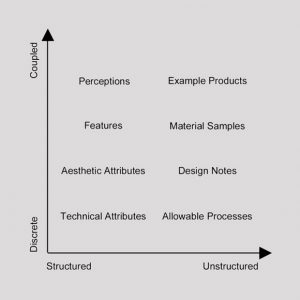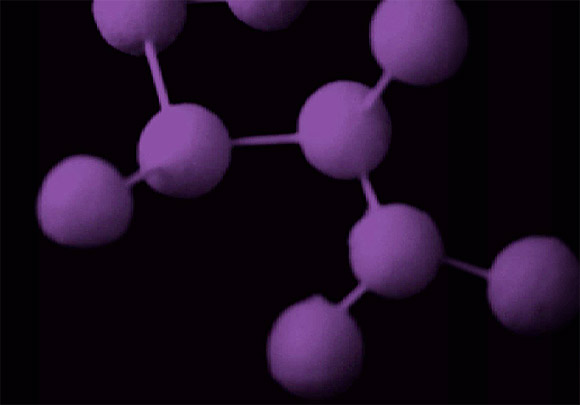The scientific study of materials (material science), architecture, and product design—each seeks to understand and manipulate the fundamental character and behavior of materials. Scientists strive to create new materials; architects, new spaces; and product designers, new products. Material science has had remarkable success in achieving the first, with the result that designers are presented with a large number of materials, an overwhelming choice. The material scientists take the first step in innovation: the inception of a new technology. The designer takes the second: the novel application of this technology. The aim of this article is to present a discussion of the language of materials in design, to lead the designer on a path toward understanding and creative manipulation.
Materials, New and Old
It may seem at first that there are a relatively limited number of materials that are commonly used in design. And it is important that designers are able to differentiate among these materials. Even with this limited number of materials, the amount of information available (but not necessarily relevant) for each is considerable. To complicate matters, new materials—insert-molded fabrics, elastomer/metal composites, biodegradable polymers, functional fabrics, ceramic foams, etc.—are constantly pushing the designer to reconsider existing material solutions. In addition to any technical or aesthetic advantages, these new materials are attractive because they provide a sense of immediate innovation.
The desire to introduce new materials or material combinations introduces the need to visualize, and thereby understand, the relationships between the “old” materials and these “new” materials. The information sources available to designers are limited and not wholly effective—suppliers and the Internet. Suppliers’ information is sometimes biased; the Internet can only provide results for materials of which the designer is already aware, and the quality of the information retrieved is inconsistent. For each material—both new and old—the information is hard to get. Some is only relevant in specific applications, some requires prior experience, some doesn’t. Ultimately, the challenge is to present this information in a creative way, so that it is simple, intuitive, inspiring, and practical. The first step is to identify what information is relevant for designers.
Information and Designers

Technical attributes describe the mechanical or thermal character of materials. Mechanical attributes include well-characterized material properties like yield strength (σy), elastic modulus (E), fracture toughness (KIC), and density (ρ). Thermal attributes include thermal conductivity (λ), specific heat (CP), and the range of possible service temperatures (Tmin, Tmax).
Aesthetic attributes are based on the senses: sight, touch, sound, smell, and taste. The attributes of aesthetics are less well characterized but can sometimes be related to technical attributes. Visual attributes include color, translucency, and reflectivity; tactile attributes include warmth and softness. Warmth is the result of the combination of a material’s thermal conductivity, specific heat, density, and sometimes color. Softness is the result of a material’s surface hardness, elastic modulus, and texture.
Material attributes are discrete; now consider information that is more coupled—the features of a material. These features are often represented by words or phrases that capture some combination of attributes or a general character. First, it is important to explore the features that can be directly related to material attributes—the mechanical features. When a material is described as “resilient” or “abrasion resistant,” this term summarizes a combination of technical attributes and character.
Resilient materials have high values of σy/ E or—in words—they are able to return to an original state after loading, without plastic deformation. Abrasion resistant materials are hard, and the surface does not deform under abrasive conditions like grinding or scratching. For some features, like “stiff and light,” the designer may have the intuition to realize that as modulus increases, stiffness increases; as density decreases, weight decreases—the relevant index is E/ρ. This is an over-simplification, but it is sometimes all that is necessary.
When behavior is abstractly, not technically, complex, it is usually the result of the subjectivity of the observer, that is, of perception. And for materials as well as products, perception is as important as the material or product itself. Materials can be perceived as “high-tech,” “clean,” “formal,” “rugged,” etc., without any particular understanding of how this behavior is created.
In a less structured way, materials can also be linked to the processes that can form or join them or alter their surfaces. These links provide insight into the behavior of materials. For example, polycarbonate can be easily joined by adhesives and coated with “soft” polyurethane. Magnesium can be easily die cast but is difficult to weld and anodize. These and other more colloquial descriptions of materials are often accumulated in notes by individual designers or in supplier-specific literature to document material behavior.
And, finally, one of the most valuable information sources for a material is a sample or a product made of that material. The next best thing is an image, both of the material and of a product made from it— a chair, for example. Thin carbon fiber weaves are translucent, and the fibers can be drawn and woven so thin that they are almost unnoticeable. These weaves are very flexible and easy to drape in a mold. Thick carbon fiber weaves, when tightly woven, do not transmit light. They can, however, be coated with resin before molding, and therefore thermoplastic/ carbon fiber composites are possible. The same combinations are possible with glass fibers. The products that are made of these materials are the best visualization of possible behavior. Eames chairs are famous as the initial manipulations of glass fiber composites in consumer products. And epoxy/carbon fiber is known for its ability to give form to thin, stiff, light structures, usually in sports equipment; it too has been realized in the form of a chair. As products, these examples are familiar expressions of material behavior when manipulated.
Classes of Materials
Any set of information, as it increases in size, must be given a classification. Each audience—scientists, engineers, architects, or designers—requires a different classification. Materials are often naturally divided into classes. These classes form the beginning of a system and describe a set of materials that have something in common.
Material science has developed a classification that suits the needs of scientists. Its classification is most easily expressed in a tree structure; it is shown, partly expanded, in the figure above. As one moves down the tree, the materials that group together are increasingly similar. At the first level, groupings are based on the nature of the atoms of the material and the bonding between them (e.g. metal); at the second level, groupings are based on the chemical differences within that family (e.g. aluminum); and, at subsequent levels, details of processing or composition are important.
Another classification, this one proposed by architects at Arup in 1997, organizes the information in a different way, emphasizing familiarity (and lack of it).
In the process of design, materials and a language to describe them are both necessary. The exercise of considering the most appropriate classification for any given audience of designers is left to the reader, but the answer lies somewhere between those presented for science and architecture. Science creates new materials, but it is the designer’s manipulation of these materials that creates new architectural spaces—like the PTFE-coated woven glass fibers on London’s Millennium Dome—or new products—like the soft, flexible silicone/fabric keypads for today’s consumer electronics. And this manipulation is only possible with a clear understanding of the path of specific materials (whether new or old)—from science to design.
Opening photo illustration by Supreeya Pongkasem.
Author Kara Johnson is the Materials Lead at IDEO, an innovation and design consultancy. Her role is that of supporting designers in the selection of materials and introducing unique methods of integrating materials in the design process.
Originally published 4th quarter 2002, in arcCA 02.4, “New Material.”








